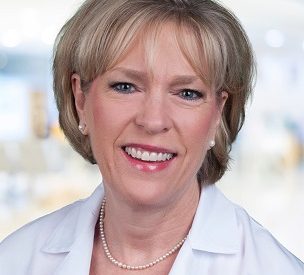Although it’s not a cure for ALS, an oral drug slowed patients’ rate of functional decline in a clinical trial that included five patients at UT Health San Antonio. If the finding is repeated in larger trials, the drug could give families more time with their loved ones who have ALS.
The New England Journal of Medicine published the results Sept. 3.

Amyotrophic lateral sclerosis (ALS) is a neurodegenerative disease for which there is no cure. Many patients die within two to three years of the onset of symptoms. Study co-author Carlayne Jackson, MD, director of the National ALS Association Center of Excellence at UT Health San Antonio, said other than a couple of symptom-treatment studies, this clinical trial is “the first we’ve been involved with that has shown a statistically significant benefit for ALS patients.”
Four drugs are approved to treat ALS, with the last, edaravone, gaining U.S. Food and Drug Administration (FDA) clearance in 2017. The new oral drug is a combination of sodium phenylbutyrate and taurursodiol, two medicines previously reported to have an effect in ALS.
“The idea was that, by combining them, we might get a greater effect,” Dr. Jackson said.
In the CENTAUR trial, patients were randomly assigned to receive either the investigational medication or a placebo, and patients and physicians were not informed of the assignment.
Of 177 patients screened for the study, 89 were randomized to receive the treatment and 48 to receive placebo. Forty patients did not meet the inclusion criteria. All participants received standard therapies currently available for ALS, with the treatment group adding the oral pill.
ALS rating scale
“We looked for a statistically significant outcome in function based upon what is called the ALS Functional Rating Scale,” said Dr. Jackson, professor of neurology and otolaryngology in the Joe R. and Teresa Lozano Long School of Medicine. “The scale is a compilation of 12 questions that address fine motor function, gross motor function, respiratory function and bulbar function, or speech and swallowing.”
The average rate of decline on the scale is one point a month, but the CENTAUR investigators intentionally chose a study population of rapidly progressive ALS patients, Dr. Jackson said. CENTAUR participants treated with the combination pill declined 1.24 points per month on average, compared to 1.66 points per month for participants on placebo. The difference is statistically significant.
“People didn’t get better, but their rate of decline was less,” Dr. Jackson said.
Longer, larger trials needed
The study was a phase two clinical trial. The combination therapy was first tested in experimental neurodegenerative disease models, and pilot clinical trials for safety in individuals with ALS also preceded the CENTAUR study.
“This was a 24-week study, so it was fairly short in duration,” Dr. Jackson said. “Longer and larger trials are necessary to evaluate the efficacy and safety of these medications.”
The next step is a phase three trial with more patients, after which, if the results remain positive, application for FDA approval would be submitted.
Acknowledgments
This study was supported by Amylyx® Pharmaceuticals Inc., the ALS Finding A Cure® Foundation and The ALS Association. The National ALS Association Center of Excellence at UT Health San Antonio is funded by the Glenn Biggs Institute for Alzheimer’s and Neurodegenerative Diseases, also at UT Health San Antonio.
Trial of Sodium Phenylbutyrate/Taurursodiol for Amyotrophic Lateral Sclerosis
Sabrina Paganoni, M.D., Ph.D.; Eric A. Macklin, Ph.D.; Suzanne Hendrix, Ph.D.; James D. Berry, M.D.; Michael Elliott, M.D.; Samuel Maiser, M.D.; Chafic Karam, M.D.; James B. Caress, M.D.; Margaret Ayo Owegi, D.O.; Adam Quick, M.D.; James Wymer, M.D., Ph.D.; Stephen A. Goutman, M.D.; Daragh Heitzman, M.D.; Terry Heiman-Patterson, M.D.; Carlayne E. Jackson, M.D.; Colin Quinn, M.D.; Jeffrey D. Rothstein, M.D., Ph.D.; Edward J. Kasarskis, M.D., Ph.D.; Jon Katz, M.D.; Liberty Jenkins, M.D.; Shafeeq Ladha, M.D.; Timothy M. Miller, M.D., Ph.D.; Stephen N. Scelsa, M.D.; Tuan H. Vu, M.D.; Christina N. Fournier, M.D.; Jonathan D. Glass, M.D.; Kristin Johnson, D.O.; Andrea Swenson, M.D.; Namita A. Goyal, M.D.; Gary L. Pattee, M.D.; Patricia L. Andres, M.S., D.P.T.; Suma Babu, M.B.B.S., M.P.H.; Marianne Chase, B.A.; Derek Dagostino, B.A.; Samuel P. Dickson, Ph.D.; Noel Ellison, M.S.; Meghan Hall, M.S.; Kent Hendrix, B.S.; Gale Kittle, R.N., M.P.H.; Michelle McGovern, B.S.; Joseph Ostrow, B.S.; Lindsay Pothier, B.A.; Rebecca Randall, M.S., R.D.; Jeremy M. Shefner, M.D., Ph.D.; Alexander V. Sherman, M.Sc.; Eric Tustison, B.A.; Prasha Vigneswaran, M.S.; Jason Walker, B.S.; Hong Yu, M.S.; James Chan, M.A.; Janet Wittes, Ph.D.; Joshua Cohen, B.S.E.; Justin Klee, Sc.B.; Kent Leslie, M.S.; Rudolph E. Tanzi, Ph.D.; Walter Gilbert, Ph.D.; Patrick D. Yeramian, M.D., M.B.A.; David Schoenfeld, Ph.D.; Merit E. Cudkowicz, M.D.
First published: Sept. 3, 2020, The New England Journal of Medicine
https://doi.org/10.1056/NEJMoa1916945
# # #
The Long School of Medicine at The University of Texas Health Science Center at San Antonio is named for Texas philanthropists Joe R. and Teresa Lozano Long. The school is the largest educator of physicians in South Texas, many of whom remain in San Antonio and the region to practice medicine. The school teaches more than 900 students and trains 800 residents each year. As a beacon of multicultural sensitivity, the school annually exceeds the national medical school average of Hispanic students enrolled. The school’s clinical practice is the largest multidisciplinary medical group in South Texas with 850 physicians in more than 100 specialties. The school has a highly productive research enterprise where world leaders in Alzheimer’s disease, diabetes, cancer, aging, heart disease, kidney disease and many other fields are translating molecular discoveries into new therapies. The Long School of Medicine is home to a National Cancer Institute-designated cancer center known for prolific clinical trials and drug development programs, as well as a world-renowned center for aging and related diseases.
The University of Texas Health Science Center at San Antonio, also referred to as UT Health San Antonio, is one of the country’s leading health sciences universities and is designated as a Hispanic-Serving Institution by the U.S. Department of Education. With missions of teaching, research, patient care and community engagement, its schools of medicine, nursing, dentistry, health professions and graduate biomedical sciences have graduated more than 37,000 alumni who are leading change, advancing their fields, and renewing hope for patients and their families throughout South Texas and the world. To learn about the many ways “We make lives better®,” visit www.uthscsa.edu.
Stay connected with The University of Texas Health Science Center at San Antonio on Facebook, Twitter, LinkedIn, Instagram and YouTube.


